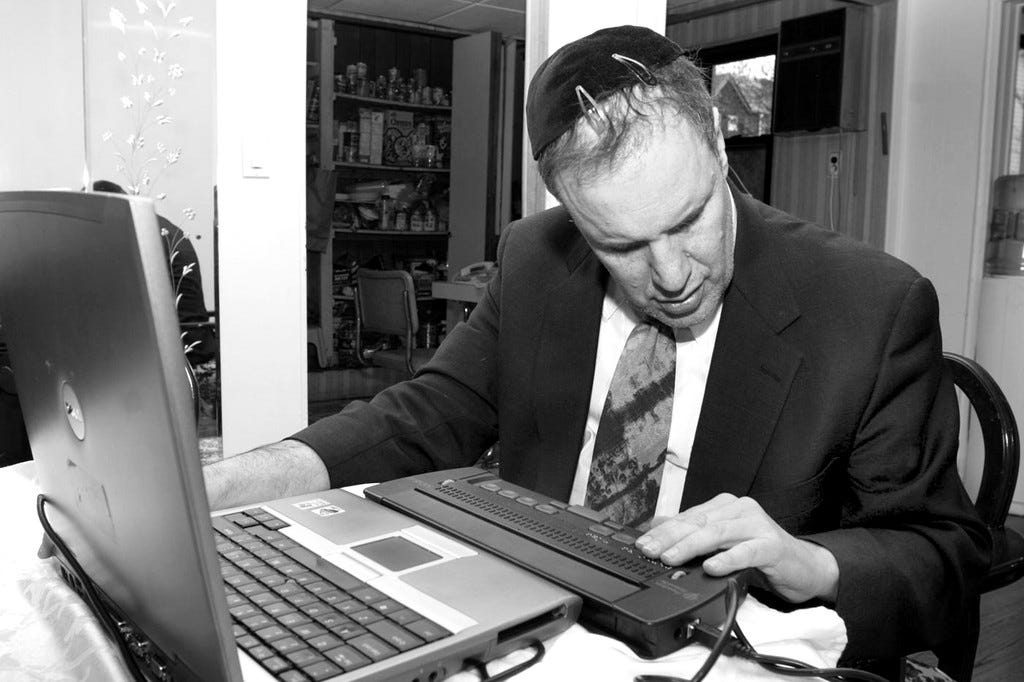With the holiday a few weeks away, it’s time to prepare for a successful integrated Hanukkah:
1. Set aside a few minutes every day to review the checklist below. What items need your attention right now?
2. Contact your synagogue and community center. Explain that you need copies of Hanukkah hand-outs and literature NOW so that they can be converted into accessible format.
3. Introduce your lay and community leaders to the concept of program access. What should you do if the candle-lighting ceremony is scheduled to be on the third floor and there is no elevator? Move the ceremony to the ground floor.
4. Remind clergy and lay leaders to notify their constituencies that people with disabilities should request Hanukkah accommodations now. Accommodations that are sometimes overlooked include: using cleaning fluids that do not irritate the chemically sensitive, quiet rooms for those who need them, and escorts to unfamiliar areas for those with visual or cognitive impairments
5. Families and friends throw Hanukkah parties at the drop of a latkes. They can welcome the disabled among them by avoiding architectural and communication barriers. If Aunt Tilly’s house has twelve steps leading into it, have her cook the food and bring it to Aunt Lilly’s accessible ground floor dining room. That way, mobility-impaired Uncle Billy can join in, even if he tells the same bad jokes every year.
6. Be creative. Modify dreidels for those who can’t read standard Hebrew letters or who find it difficult to give the standard dreidel a hefty spin.
7. The Devil is in the details. Make sure that people with disabilities or their families have elevator keys in case Mr. Higgins the custodian at the synagogue or community center calls in sick the day of the Hanukkah event.
8. Some celebrants are allergic to the confections in standard “Hanukkah gelt.” Consult your foodie friends for culinary substitutes that still look like gelt.
9. Make this Hanukkah memorable for disabled and non-disabled alike. Everybody who wishes has her solo moment—starting a song or dance, positioning ringing out the menorah with fanfare, announcing which candle burned the longest. Everybody pulls his weight: setting the table, cleaning up, handing out the gelt.
WE are all on God’s sacred spectrum. May He bless us with peace and light during this Hanukkah season.
A native of Bradley Beach, New Jersey, Rabbi Michael Levy attributes his achievements to G-d's beneficence and to his courageous parents. They supported him as he learned to travel independently, visited Israel, and became more Jewishly observant. For 65 years, JBI International supported him with braille and recorded Judaica material.
He received rabbinic ordination from the Jewish Theological Seminary in 1981 and an MSW from Columbia University in 1982.
As a board member and now President of Yad Hachazakah, Rabbi Levy strives to make the Jewish experience and Jewish texts accessible to Jews with disabilities. In lectures at synagogues, camps, and educational institutions, he cites Nachshon, who according to tradition boldly took the plunge into the Red Sea even before it miraculously parted. Rabbi Levy elaborates, "We who have disabilities should be Nachshons--boldly taking the plunge into the Jewish experience, supported by laws and lore that mandate our integration.”
He applauds Jewish Disability Inclusion News’s ambition to give voice not just to those who work with the disabled, but also to people with disabilities themselves. “About us? Not without us” he is fond of reminding those eager to listen, and the media to whom the maxim may be out of their comfort zone.
For over 20 years, Rabbi Levy served as director of Travel Training at MTA New York CityTransit. Now retired, he is an active participant in Congregations Aish Kodesh and Young Israel in Woodmere, New York. Most of all, he relishes the company of his children, grandchildren, and large extended family.





I love this Rabbi Levy - we are all on God’s sacred spectrum. Just takes being able to do traditions differently to make inclusion work.